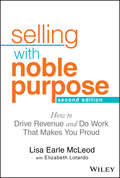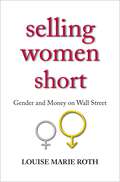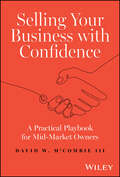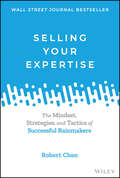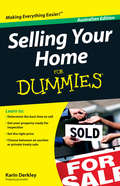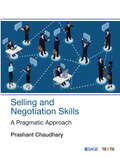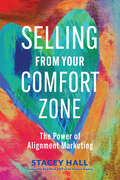- Table View
- List View
Selling With Noble Purpose: How to Drive Revenue and Do Work That Makes You Proud
by Lisa Earle McLeodDon’t let anyone tell you that you have to choose between making money and making a difference. Selling With Noble Purpose: How to Drive Revenue and Do Work That Makes You Proud, 2nd Edition is an update of the acclaimed book that changed the game in sales. Using real-world data, compelling stories and psychological research, Selling With Noble Purpose explains why salespeople who genuinely understand how they can make a difference to customers outsell those who only focus on internal targets and quotas. Sales leadership experts McLeod and Lotardo reveal how a Noble Sales Purpose (NSP) can drive a team to outstanding sales numbers. Whether you’re an executive, manager or aspiring sales leader, you’ll discover how to find your own Noble Sales Purpose and create a sales force of True Believers. This new edition covers: How firms overcome ferocious competition and how you can do the same Why sales organizations with a clear NSP outperform traditional sales teams How to avoid the trap of behaving like a transactional salesperson Why well-intended leaders often unknowingly erode purpose and differentiation How to use your NSP to increase customer engagement Why an NSP gives you clarity during times of uncertainty In an era where organizations often believe that money is the primary way to motivate salespeople, Selling with Noble Purpose offers and exciting and sustainable alternative.
Selling Women Short: Gender and Money on Wall Street
by Louise Marie RothRocked by a flurry of high-profile sex discrimination lawsuits in the 1990s, Wall Street was supposed to have cleaned up its act. It hasn't. Selling Women Short is a powerful new indictment of how America's financial capital has swept enduring discriminatory practices under the rug. Wall Street is supposed to be a citadel of pure economics, paying for performance and evaluating performance objectively. People with similar qualifications and performance should receive similar pay, regardless of gender. They don't. Comparing the experiences of men and women who began their careers on Wall Street in the late 1990s, Louise Roth finds not only that women earn an average of 29 percent less but also that they are shunted into less lucrative career paths, are not promoted, and are denied the best clients. Selling Women Short reveals the subtle structural discrimination that occurs when the unconscious biases of managers, coworkers, and clients influence performance evaluations, work distribution, and pay. In their own words, Wall Street workers describe how factors such as the preference to associate with those of the same gender contribute to systematic inequality. Revealing how the very systems that Wall Street established ostensibly to combat discrimination promote inequality, Selling Women Short closes with Roth's frank advice on how to tackle the problem, from introducing more tangible performance criteria to curbing gender-stereotypical client entertaining activities. Above all, firms could stop pretending that market forces lead to fair and unbiased outcomes. They don't.
Selling Women's History: Packaging Feminism in Twentieth-Century American Popular Culture
by Emily WestkaemperOnly in recent decades has the American academic profession taken women's history seriously. But the very concept of women's history has a much longer past, one that's intimately entwined with the development of American advertising and consumer culture. Selling Women's History reveals how, from the 1900s to the 1970s, popular culture helped teach Americans about the accomplishments of their foremothers, promoting an awareness of women's wide-ranging capabilities. On one hand, Emily Westkaemper examines how this was a marketing ploy, as Madison Avenue co-opted women's history to sell everything from Betsy Ross Red lipstick to Virginia Slims cigarettes. But she also shows how pioneering adwomen and female historians used consumer culture to publicize histories that were ignored elsewhere. Their feminist work challenged sexist assumptions about women's subordinate roles. Assessing a dazzling array of media, including soap operas, advertisements, films, magazines, calendars, and greeting cards, Selling Women's History offers a new perspective on how early- and mid-twentieth-century women saw themselves. Rather than presuming a drought of female agency between the first and second waves of American feminism, it reveals the subtle messages about women's empowerment that flooded the marketplace.
Selling Words: Free Speech in a Commercial Culture (Critical America #79)
by R. George WrightAll of us grumble, from time to time, about the ever-increasing commercialization of American life. Whether in the form of overt corporate sponsorship—as evidenced by the "branding" of every major sporting event—or the less conspicuous role of commercial interests in the funding of the arts, America's corporations are a ubiquitous presence. While debates rage over the televising of liquor ads and the degree to which Joe Camel encourages adolescent smoking, of far greater concern, R. George Wright argues, should be the passivity with which we accept excessive commercialization. For many, the spread of commercialization by any means other than fraud or deception today seems merely a reflection of the capitalist pursuit of well-being. Yet owning and spending, for the middle- class consumers Wright discusses, is at best only weakly related to their happiness. In recent years, corporate America has shrewdly sought shelter from reasonable regulation by embracing the First Amendment. Focusing on such flashpoint issues as the Internet, tobacco advertising, and intentionally controversial ads, and exposing the dangerous elephantiasis of our commercial culture, Selling Words serves up a forceful warning about the perils of conflating commerce with First Amendment rights.
Selling Your Business For Dummies
by John Davies Barbara Findlay SchenckA hands-on tool for conducting the successful, profitable sale of a businessAs business owners gray, trends have shown that they start thinking of cashing out. Selling Your Business For Dummies gives readers expert tips on every aspect of selling a business, from establishing a realistic value to putting their business on the market to closing the deal. It helps them create sound exit plans, find and qualify, find and qualify a buyer, conduct a sale negotiation, and successfully transition the business to a new owner. The accompanying CD is packed with useful questionnaires, worksheets, and forms for prospective sellers, as well as a blueprint for customizing and assembling information into business sale presentation materials sale presentation materials --including snapshots of revenue and profit history, financial condition, market conditions, brand value, competitive arena, growth potential, confidentiality agreements, and other information that supports the sale price.Note: CD-ROM/DVD and other supplementary materials are not included as part of eBook file.
Selling Your Business for Dummies
by Alexander G. Schenck John Davies Barbara Findlay SchenckA hands-on tool for conducting the successful, profitable sale of a business. As business owners gray, trends have shown that they start thinking of cashing out. Selling Your Business For Dummies gives readers expert tips on every aspect of selling a business, from establishing a realistic value to putting their business on the market to closing the deal. It helps them create sound exit plans, find and qualify, find and qualify a buyer, conduct a sale negotiation, and successfully transition the business to a new owner. The accompanying CD is packed with useful questionnaires, worksheets, and forms for prospective sellers, as well as a blueprint for customizing and assembling information into business sale presentation materials sale presentation materials -- including snapshots of revenue and profit history, financial condition, market conditions, brand value, competitive arena, growth potential, confidentiality agreements, and other information that supports the sale price.
Selling Your Business with Confidence: A Practical Playbook for Mid-Market Owners
by David W. McCombie IIIA comprehensive handbook for middle-market business sellers In Selling Your Business with Confidence: A Practical Playbook for Mid-Market Owners, veteran M&A advisor David McCombie delivers an insider's guide to navigating the mergers and acquisitions (M&A) sales process. In plain English, this book covers every essential topic for owners considering the sale of their business. Readers will fully understand the process, the range of options available, and their implications. In the book, you'll learn to navigate every step of the exciting—yet stressful—business sale journey, such as: The overall timeline, mechanics, and typical strategies of a deal Understanding different types of buyers and what they prioritize Tactics you can implement immediately to make your company more valuable Strategies for emotionally and psychologically preparing yourself for the transaction An essential roadmap to the complicated world of mid-market M&A transactions, Selling Your Business with Confidence is a must-have resource for business owners and the ecosystem of professionals who serve them.
Selling Your Crafts at Craft Shows: Storey's Country Wisdom Bulletin A-156 (Storey Country Wisdom Bulletin Ser.)
by Madelaine GraySince 1973, Storey's Country Wisdom Bulletins have offered practical, hands-on instructions designed to help readers master dozens of country living skills quickly and easily. There are now more than 170 titles in this series, and their remarkable popularity reflects the common desire of country and city dwellers alike to cultivate personal independence in everyday life.
Selling Your Crafts: Revised Edition
by Susan Joy SagerDrawing upon profiles of established artisans and the helpful insights of small-business entrepreneurs, this unique guide not only gives tactics for promoting and marketing crafts, but also provides the necessary forms for getting a business up and running. The book details how to network effectively and build a customer base, listing organizations, business associations, and crafts publications that offer further sources of information. Filled with easy-to-understand examples and sample forms and contracts, this book provides the essential tools for prospering in the crafts business, as well as the resources needed to keep savvy as business grows.
Selling Your Expertise: The Mindset, Strategies, and Tactics of Successful Rainmakers
by Robert ChenBuild your book of business and sell more services with this expert guide for knowledge professionals How do rainmakers consistently and continuously sell their ideas and grow their client base? What is the secret to their ongoing success? Whether they are in accounting, consulting, investment banking, law, or any other type of professional service, it’s not just their knowledge, experience, and unique services that set them apart. They succeed by adopting the mindset, mastering the strategies, and employing the tactics at the heart of rainmaking. In Selling Your Expertise: The Mindset, Strategies, and Tactics of Successful Rainmakers, veteran communications, sales, and leadership consultant Robert Chen provides a practical guide to selling knowledge-based services in a market that demands credibility and subject-matter authority. Chen and his colleagues at Exec|Comm have helped hundreds of thousands of professionals learn to sell, influence, and negotiate more effectively. This book condenses Chen’s first-hand experience and over 40 years of Exec|Comm’s best sales advice, along with interviews featuring other successful rainmakers from a variety of professions and industries. Whether you’re a national practice partner at a Big Four consulting firm or an independent attorney just starting out, this book equips you with the real-life knowledge you need to: Develop a client-focused mindset to help build a thriving book of business Use effective strategies to find your ideal prospects and turn them into long-term clients, using concrete metrics to assess whether you’re on the right track Apply practical tactics to build a trusted reputation, sharpen communication skills, manage the challenges of not having enough time to sell, and push beyond obstacles The perfect book for consultants, investment bankers, lawyers, research analysts, and accountants, Selling Your Expertise is an invaluable resource for any professional who makes a living by selling solutions to their clients’ most pressing needs.
Selling Your Home For Dummies
by Karin DerkleySell your home for the best possible price Thinking of selling up but not sure whether it's the right time, or how to go about it? From helping you decide whether selling really is the best option for you, to finding an agent and choosing a sales method, all the way to exchanging contracts, this step-by-step guide covers all the practical, financial and legal aspects of selling your home. Work out whether you're ready to sell - consider all the options and decide if selling is the way to go Find out when you should sell - understand supply and demand, and time your sale perfectly Choose a real estate agent who's right for you - find the best fit for you and your home Set the right price - understand what drives the value of property and determine a realistic asking price for your home Get your home looking its best before selling - find out whether a clean-up will do, or if it's worth renovating before you sell Choose a selling method - get step-by-step instructions for selling by private treaty and auction Understand the legal stuff - do the paperwork properly to ensure a smooth sale Open the book and find: In-depth information about working with property professionals Strategies for selling first then buying, or buying first then selling Tips and tricks for sprucing up your property for inspections How to avoid over-capitalising Everything you need to know about selling a holiday or rental property Learn to: Determine the best time to sell Get your property ready for inspection Set the right price Choose between an auction or private treaty sale
Selling Your House
by Ilona Bray J.D. Alayna SchroederAcross the U.S., home prices are in flux - rising in some areas, stagnant in others. So what's the best way to get the highest return if you want to sell your home now? Selling Your House: Nolo's Essential Guide provides the practical and legal steps you'll need to take to reach your goal. Written with the current market and national economy in mind, this book goes over the specifics that homeowners need to know to make the sale. Whether you're selling your property because of a job change, growing family, or financial troubles, you'll get the information and guidance you need, including how to: check out your local market decide on the right price hire the best real estate professionals to help you dress up, market, and otherwise set your house apart from the pack make required disclosures negotiate and successfully close the sale. Selling Your House: Nolo's Essential Guide draws on input from a wide range of experts, helping you conclude a sale you'll be satisfied with, no matter the state of your local housing market.
Selling Your House For Dummies
by Eric Tyson Ray BrownSell your house in any market Whether you're selling your home yourself or using a realtor, this helpful guide offers all the information you need to make an otherwise-stressful undertaking go smoothly. In Selling Your House For Dummies, you'll find plain-English, easy-to-follow information on the latest mortgage application and approval processes, the hottest websites used in the house-selling process, and revised tax laws that affect the housing and real estate markets. From the author team behind America's #1 bestselling real estate book, Home Buying Kit For Dummies, this book offers Eric Tyson and Ray Brown's time-tested advice, recommendations, and strategies for selling your house given current market conditions. From staging your home to utilizing technology to sell your house directly to home buyers, this trusted resource is packed with tips and ideas to make your home the most appealing house on the block. Prepare your property for the best offer Stage and market your house successfully Negotiate and successfully close the sale Make sense of contracts and forms used in the house-selling process Get the tried-and-true advice that will help you sell your property!
Selling Your House in a Tough Market
by Ilona Bray J.D.Sell your house quickly at the best price in any market! National median home prices dropped 7.9% between 2005 and 2008, and the downward trend shows no signs of slowing. So what do you do if you want to sell your home now, when the getting a good price for your investment seems nearly impossible? If you want to maximize your return and close the deal quickly, Selling Your House in a Tough Market provides the practical and legal steps you'll need to take to reach your goal. Written with the current market and national economy in mind, this book goes over the specifics that homeowners need to know to make the sale. Whether you're selling your property because of a job change, growing family, or financial troubles, you'll get the information and guidance you need, including: knowing your local market picking the right price hiring the best professionals marketing and setting your house apart from the pack how and when to consider options other than a sale, such as renting negotiating the sale Selling Your House in a Tough Market is the only book available that gives you proven strategies to maximize the return on your investment in your home, no matter what the state of your local housing market.
Selling Your House: Nolo's Essential Guide
by Ilona BrayBuyers can’t wait to get a look at your home—but what’s the best way to earn the highest return? You may hope to inspire multiple offers, but also want to make sure to choose a buyer who will close the deal without last-minute issues or drama. Selling Your House: Nolo's Essential Guide provides the practical and legal guidance you'll need to make the deal happen. Whether you're moving up or downsizing, or selling because of a job change, growing family, or financial troubles, you'll get useful information that will help you: figure out how much comparable homes are selling for decide on the right price hire real estate professionals to help you dress up, market, and otherwise set your house apart from the pack make required disclosures, and negotiate and successfully close the sale. Selling Your House: Nolo’s Essential Guide draws on input from a wide range of experts, helping you conclude a sale you’ll be satisfied with, no matter the state of your local housing market.
Selling Your House: Nolo's Essential Guide
by Ilona Bray J.D.What’s the best way to get the highest return if you want to sell your home now? With pent-up demand for homes, you hope yours will inspire multiple offers; but want to make sure to choose a solid one that will proceed successfully to closing. Selling Your House: Nolo's Essential Guide provides the practical and legal steps you'll need to take to reach your goal. Written with the current market and national economy in mind, this book goes over the specifics that homeowners need to know in order to make the sale. Whether you're selling your property because of a job change, growing family, or financial troubles, you'll get the information and guidance you need, including how to: check out your local market decide on the right price hire the best real estate professionals to help you dress up, market, and otherwise set your house apart from the pack make required disclosures, and negotiate and successfully close the sale. Selling Your House: Nolo's Essential Guide draws on input from a wide range of experts, helping you conclude a sale you’ll be satisfied with, no matter the state of your local housing market.
Selling Your IT Business
by Robert J. Chalfin"For close to twenty years I have observed Mr. Chalfin helping owners, business advisors, and students get a grip on the slippery issues of selling a business. This book is a valuable distillation of his expertise. "--Ian MacMillan, Dhirubhai Ambani Professor of Innovation and Entrepreneurship The Wharton School, University of Pennsylvania"Bob provided us with valuable outside perspective while we prepared our business for sale and during the sale process. His book is an excellent guideline for business owners thinking about selling their company."--Steve Gerlicher, Entrepreneur"Bob Chalfin's experience and intellect make this book essential reading for IT business owners. Provides thoughtful analysis and practical advice invaluable to anybody who is even considering selling their business."--Louis W. Fryman, Esq. Chairman Emeritus Fox Rothschild LLP"Bob Chalfin brings unparalleled experience to developing and executing these transactions. His insights are tempered by years of formulating these deals and then describing the methods to hundreds of students at The Wharton School."--Stephen M. Sammut Senior Fellow, Wharton Entrepreneurial Programs Managing Director, Burrill International"This book covers all the bases for someone selling an IT (or really any) business. The observations on buyer motivations are particularly insightful."--Mark Goodwin Executive Vice President and Chief Operating Officer Pioneer Investments
Selling Your Photography: How to Make Money in New and Traditional Markets
by Richard WeisgrauSelling Your Photography is the road map to help photographers find their way through the complexities of the marketplace and get their images published! This insider's guide examines magazines, newspapers, books, posters, greeting cards, calendars, brochures, print and Web advertisements, annual reports, and more. Chapters cover how to:· Break into diverse markets · Shoot and sell stock and assignment photography · Find advertising, corporate, editorial, and merchandise segment clients · Work with photo editors, art directors, and communication directors · Market your photography · Develop good business habits · License and price your work · Get new clients through past publication · Make additional sales with the same photographsAnyone who plans to have his or her images published will need this handy guide.
Selling Your Startup: Crafting the Perfect Exit, Selling Your Business, and Everything Else Entrepreneurs Need to Know
by Alejandro CremadesLearn how to sell your startup from an acquisition expert Many entrepreneurs dream of the day their company is acquired and they secure a perfect exit. But information about the process of getting your business acquired usually comes from expensive investment bankers who typically advise late-stage startups. In Selling Your Startup, serial entrepreneur Alejandro Cremades delivers an accessible guide on how to sell your startup. With first-hand experience as a fully exited entrepreneur, investment banker, and lawyer, Cremades describes the tips and tricks startup founders need to sell their early-stage to growth-stage business. In this book, you’ll discover: The role that investment bankers play in the acquisition process, how they add value, and how to break down their fees Preparing your company for sale, including compiling a pitch book, putting its finances in order, and building a target list of potential acquirers How to get to a Letter of Intent, perform due diligence, and reach a purchase agreement Perfect for entrepreneurs of all kinds, Selling Your Startup is a must-have roadmap to the practical realities of company acquisition and contains proven guidance on crafting your perfect exit.
Selling Your Value Proposition: How to Transform Your Business into a Selling Organization
by Helen Blake Cindy Barnes Tamara HowardA value proposition is created from the combination of a company's products and services, and the value gained by the customer. It is used to drive better business, and is essential to success for any business - without it, companies are at risk of losing customers and being drowned out in crowded marketplaces. Selling Your Value Proposition is a practical, user-friendly guide to establishing a streamlined customer-centric selling process to communicate and express value propositions, enabling companies to convey their value-creating stories to customers consistently. Featuring case studies and interviews with renowned business leaders and influencers, Selling Your Value Proposition demonstrates how value propositions adeptly position a business across a range of industries. The techniques and skills shared have all been honed through the authors' experience with more than 600 companies around the world, and clear, step-by-step guidelines will empower all readers to effectively focus their value propositions for competitive success.
Selling and Negotiation Skills: A Pragmatic Approach
by Prashant ChaudharyAn indispensable companion to every student and professional who hopes to master the art of negotiation and selling. In today's challenging business environment and transforming consumer behaviour, selling and negotiation skills are paramount in gaining competitive advantage and to drive success. This comprehensive yet concise book dwells upon these critical skills at large, covering the varied sales approaches and strategies along with negotiation styles and tactics. The text is interspersed with numerous illustrative examples from diverse real-life situations for an easy understanding of the subject. Written in a simple, lucid language and filled with essential tools and helpful tactics, Selling and Negotiation Skills: A Pragmatic Approach simplifies the whole negotiation process to achieve a win-win situation for everyone. The book's practical and highly effective framework aims to help the readers harness the much-needed selling and negotiation skills to their advantage. Key Features • Complex concepts elaborated through innovative examples, tables and schematic diagrams • Illustrations from mythology, movie scenes and simulated role plays • Caselets in each chapter; three major case studies from international affairs, diplomatic dialogues and war-based negotiations
Selling and Negotiation Skills: A Pragmatic Approach
by Prashant ChaudharyThis book is a complete guide to learning the critical selling and negotiation skills to gain a competitive edge in a challenging business environment. The volume covers various negotiation approaches, strategies, tactics and styles that are adaptable and compatible with emerging business models and technologies. Businesses worldwide are adapting to changing consumer behaviour and focusing on more sustainable and future-ready selling and negotiation strategies. Richly illustrated with examples from diverse domains and real-life situations for an easy understanding of the subject, this book looks at strategies, tactics and styles for negotiation and the tools or technologies used for effectively selling; business cases and scenarios that illustrate the direct application of concepts, making the book practical, accessible and relevant and customer-centric selling and negotiation strategies, processes and approaches. A valuable companion for students, teachers, research scholars and professionals working in sales, business and management, this revised edition will also be of interest to those working in the areas of global business and trade, international affairs, marketing and economics.
Selling as a Systematic Process
by Amar V. Bhide Michael AlterDescribes a systematic approach to selling. The author, a former IBM salesman, believes that selling requires progressing through a series of stages, which culminate in "getting the order." Describes several techniques useful in managing this progression.
Selling from Your Comfort Zone: The Power of Alignment Marketing
by Stacey HallYou don't have to betray yourself or your values to close stellar sales. This book introduces a simple formula for a personalized approach to building connections through alignment and problem-solving.So many salespeople believe that they have to push themselves out of their comfort zones and compromise their values to sell products. But, as Stacey Hall shows, the comfort zone can actually be a power zone that leads to sales, satisfaction, and success. Selling from Your Comfort Zone shifts away from pushy and spammy sales tactics and instead shows how you can bring meaning to your role as a salesperson. Hall teaches how to remain in alignment with your calling, with yourself, with what you are selling, with your prospects, and with what you are saying to your prospects. By being aligned with your core values and personality traits, you will have more confidence, energy, and courage to achieve your goals, which greatly increases the chances of success. Studies reveal that while men generally rely on improving and driving outcomes to close sales, women tend to emphasize building connections, shaping solutions, and collaborating. Hall's Alignment Marketing formula combines both skillsets in an easy-to-follow process for gently expanding your comfort zone to the edge of its safe boundaries. By adopting this approach, you can stay flexible and resilient in the face of problems and objections that all salespeople encounter along the way.
Selling in 4 Weeks: The Complete Guide to Success: Teach Yourself
by Christine Harvey Grant Stewart Di MclanachanWhatever your degree of prior knowledge, this 28-day course will put you on the path to business success. It includes four tried-and-tested bestselling titles - Successful Selling in a Week; Key Account Management in a Week; Successful Customer Care in a Week; Successful Negotiation in a Week. Each day of the course is packed with proven and practical advice, and is rounded off by a quiz which helps you ensure you have understood the key areas.
